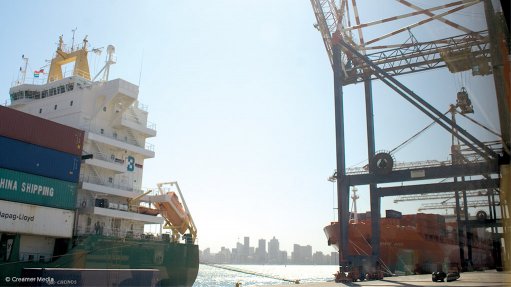
Photo by: Duane Daws
Although the Port of Durban operates 24 hours a day, seven days a week, there are critical problems with access. There are times when the port and the roads and yards are deserted.
At other times, the traffic is backed up so that drivers have to wait for hours, sometimes days, to get into the port.
Transnet KwaZulu-Natal Operations GM Zeph Ndlovu outlined these issues during a presentation at the Transport Forum Special Interest Group last week.
He said the greatest concern was the escalation of this problem, especially in light of increased activity in the port.
Durban's port is already regarded as the biggest and busiest in Africa.
With Transnet's proposed R300-billion infrastructural investment, it will get even bigger, especially when it comes to container traffic. The port’s container-handling capacity is expected to grow from the current 3.2-million containers a year to 4.6-million containers a year by 2018.
The biggest problem is the constricted and congested road network through Durban, he highlighted.
Ndlovu compared South African ports with European ports such as Rotterdam and Le Havre. The port capacities and constraints were similar but the European ports were handling far greater volumes of containers without major bottlenecks, he pointed out.
“Our problem in South Africa is that we have this mindset that we only work office hours. So, companies send their trucks off in the morning to get to the port before 16:00. This means that, every day, the roads are choked with container traffic.
“The trucks are stacked and parked all over the place, creating hazards and inconveniences to Durban residents. But by 19:00 the roads are empty, the yards stand idle and the trucks are on their way back to their head offices,” he said.
Transnet was trying to encourage freight companies to dispatch their trucks to take advantage of slow times at the port in order to decrease waiting time and congestion, Ndlovu noted.
With a limited number of access roads to the port, it might sound simple to design some kind of computerised stacking system, which would regulate the flow of traffic, but the main sticking point is the fragmented nature of the freight and transport industry.
“We are working on a strategy to bring together all the role-players in the freight industry to agree on a system to control and regulate the flow of traffic into the city and the port,” South African Shippers Council CEO Brenda Horne-Ferreira told delegates at the same convention.
At the moment, the trucking and freight industry is unregulated, with a number of large industry players, but also with hundreds of small companies running one or two trucks.
“We all know that this is a huge problem, but we need to first get everyone together in order to work on a solution,” she said.